“Hagiographies are narratives of becoming, possibility, and immanence.”
Blake Gutt and Alicia Spencer-Hall
______________________________
______________________________
The following is an introduction and invocation I provided to the book launch of Trans and Gender Queer Subjects in Medieval Hagiography on 26 May 2021.
______________________________
______________________________
Yet each piece of the stained glass window is also a mirror. And it may reflect back to us long existing prejudice and ignorance. If this movement might be called the Transgender Turn, then we must face the existence of the cisgender turn that has been the field’s modus operandi for generations. By the cisgender turn, I refer first to the fact that medieval studies has been the nearly exclusive territory of cis scholars. Even now, most trans scholars in medieval studies are working in precarious contingent positions and a growing number of scholars who have helped create the field of medieval trans studies are not able to professionally survive in it. Secondly, we might reflect that a problem within the cisgender turn is the way that the Middle Ages has been un-transed, with people, events, behaviors, and pieces of art warped through cis perspectives to conform to what I call compulsory-cisgender-assignment and cis histories. Reflecting back these patterns to the field, medieval trans studies is not so much trans-ing the Middle Ages as returning the erased or excluded transness that has been at the heart of so much medieval history and art.
The stained glass of medieval trans studies is also a third thing: a work of art in itself. By way of closing, I’ll uplift three qualities of trans joy that play critical roles in this art: resonance, radiance, and glory. Trans people have a special resonance with objects and networks. Trans women have a certain allure and sensitivity to physical and social matters of womanhood. When one sees a trans person connecting with clothes, tools, places, and systems that resonate with their authentic self, a radiance emerges. The effects of trans radiance is an euphoria or ecstasy that can animate, reanimate, orient, and reorient the world. I suspect this radiance is what transphobes most fear. Transphobes are comfortable with our discomfort, they encourage our dysphoria. But our radiance scares them; in this authentic truth trans people affect others, arousing hidden truths, ignored perspectives, and denied glories. For me, trans glories mark those points where being meets becoming, where potential and actual cross paths. The effect of glory is a sense of being totally in the now and yet also speaking across polychronic experiences of dysphoric time. Medieval trans studies is one such glory that burns with radiant light and radiant darkness, responding to a resonance between now and elsewhile, here and elsewhere, you and me and we.
May these resonant, radial, and glorious transgender joys bless each of us, the field, this book, those who came before and those facets yet to add their piece to the composition.
______________________________
______________________________



